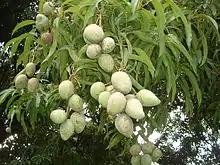Harivanga
The 'Harivanga' mango (or Haaribhanga), is a mango cultivar produced in the northwest part of Bangladesh, especially in Rangpur district. Cultivation of the Harivanga mango has recently gained popularity among the farmers of northern districts. Locally called Harivanga, these mangoes are round in shape and black in color. Harivanga are highly fleshy, fiberless, and typically weigh 200 to 400 grams. They have been recorded weighing up to 700 grams.[1]
| Mangifera 'Harivanga' | |
|---|---|
 Unripe mangoes on a mango tree | |
| Genus | Mangifera |
| Cultivar | 'Harivanga' |
| Origin | Bangladesh |
History
Harivanga was introduced around 2003 by Abdus Salam Sarkar. Harivanga now sees large-scale cultivation in Mithapukur, Badarganj, Pirganj and Sadar upazilas in Rangpur district as well as other areas of the northern region, the Department of Agriculture Extension (DAE) working to develop of Harivanga.[2]
Economy
Around 30 thousand people of Mithapukur and others upazilas of Rangpur district are directly dependent on the cultivation and trading of mango. Traders from Dhaka, Rajshahi, Barisal, Chittagong, Khulna, and Sylhet are thronging the local markets to buy harivanga from here. In season, this variety of mango sells wholesale at Tk 1800–2000 per maund ($0.27–0.30 per pound).[3]
References
- "রংপুরের বিখ্যাত হাড়িভাঙ্গা আম". Bangladesh National Portal. 5 Jul 2019. Archived from the original on 5 July 2019. Retrieved 5 Jul 2019.
- "Newly developed haribhanga wins hearts of connoisseurs". The Daily Star. 2012-07-25. Retrieved 2019-07-05.
- "Naogaon farmers turning croplands into mango orchards". Dhaka Tribune. 2019-06-14. Retrieved 2019-07-05.
